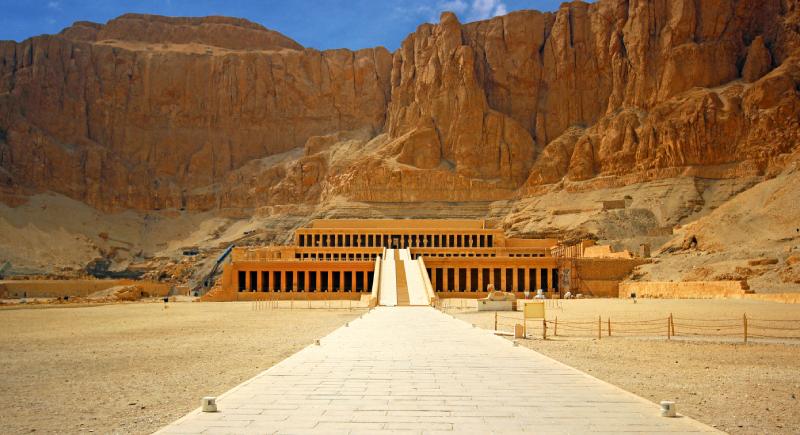
The Temple of Hatshepsut ranks among the world's most striking architectural masterpieces. One of ancient Egypt's first female pharaohs built this marvel and ruled for more than two decades during the 18th dynasty. The temple, called "Djeser Djeseru" or "holy of holies," stood next to Mentuhotep II's temple to strengthen Hatshepsut's position among kings. This remarkable structure displays its time's extraordinary architectural vision through stepped platforms, pillared porticoes, and vibrant reliefs.
Queen Hatshepsut’s temple at Deir el-Bahri stands as a powerful symbol of her reign, blending political influence and religious devotion. Beyond honoring her legacy, it served as a mortuary and sacred temple for deities like Amun and Hathor. Despite efforts by Thutmose III to erase her memory, the temple remains a lasting tribute to one of Egypt’s most remarkable rulers.
The Temple of Hatshepsut is located in Deir el-Bahari on the west bank of the Nile, across from Luxor, within the Theban Necropolis. Its position was chosen for both its dramatic limestone cliff backdrop and its alignment with the winter solstice sunrise, a symbolically important event in ancient Egyptian religion. Reaching the site is easy,just a short ferry ride and taxi from Luxor,offering scenic views of the Nile and surrounding landscapes. Nearby attractions like the Valley of the Kings, the Ramesseum, and Medinet Habu make it a key stop on any archaeological tour. The temple’s location enhances its historical, spiritual, and architectural significance.

Queen Hatshepsut built her temple at Deir el-Bahari to affirm both religious devotion and political legitimacy in a male-dominated world. Named "Djeser-Djeseru" or "Holy of Holies," the temple served as a mortuary site for herself and her father Thutmose I, with offerings meant to sustain their spirits. It honored multiple deities, including Amun, Hathor, Anubis, and Ra-Horakhty. Politically, the temple was a bold statement,its grand design and reliefs depicted Hatshepsut’s divine birth and right to rule. Modeled after Mentuhotep II’s nearby temple but far grander, it reinforced her link to Egypt’s past while asserting her superiority. Built over 15 years, it fulfilled her goals of divine association and enduring legacy.
The Temple of Hatshepsut bears witness to over three thousand years of Egyptian history, with construction commencing in 1479 BCE under the female pharaoh's watchful eye. Queen Hatshepsut entrusted her favored architect Senenmut with this monumental task, which required approximately 15 years to complete. While Senenmut found inspiration in Mentuhotep II's temple,constructed six centuries earlier,he executed his vision on a dramatically enlarged scale, creating something altogether more ambitious.
Death brought no peace to Hatshepsut's magnificent structure. Approximately two decades after her passing in 1458 BCE, her stepson Thutmose III orchestrated a calculated campaign to remove her from history. Royal workers methodically chiseled away her images and names from monuments throughout Egypt. Further desecration awaited during the controversial Amarna Period, when Pharaoh Akhenaten commanded the destruction of depictions of traditional Egyptian deities, particularly targeting representations of Amun.
Natural disasters, including a massive earthquake during the Third Intermediate Period, caused significant damage to the Temple of Hatshepsut. Repairs were made over time, notably under Tutankhamun, Horemheb, and Ramesses II. During the Ptolemaic period, a new portico was added to the sanctuary of Amun. Later, in the 6th to 8th centuries AD, a Coptic monastery covered the original reliefs with Christian imagery. Rediscovered by Richard Pococke in 1737, the temple saw excavation efforts by Auguste Mariette, Édouard Naville, and others until the Egyptian Antiquities Service joined in. Restoration work, led by the Polish Center of Mediterranean Archeology, was completed in 2023.

The construction of the Temple of Hatshepsut was a monumental task that required the expertise and labor of countless artisans, architects, and workers. Led by Hatshepsut's trusted architect Senenmut, the project involved carving the temple directly into the limestone cliffs, a technique that not only provided structural stability but also emphasized the temple's connection to the natural world. The use of local materials and resources highlights the Egyptians' ingenuity and resourcefulness. Today, visitors can witness this marvel firsthand through expertly guided Egypt Tours, which offer deep insight into the site's history and craftsmanship.
The Temple of Hatshepsut features three grand terraces, each with a unique purpose. The lower terrace includes colonnades and a wide courtyard, while the middle terrace houses chapels to deities like Amun, Anubis, and Hathor. The upper terrace contains the sanctuary used for rituals. Built with exceptional precision, the temple showcases detailed reliefs depicting Hatshepsut’s divine birth, coronation, and trade missions. These carvings not only document her reign but also reinforce her legitimacy as a pharaoh. Blending religious devotion with political messaging, the temple stands as a powerful symbol of ancient Egypt’s architectural mastery and artistic brilliance.
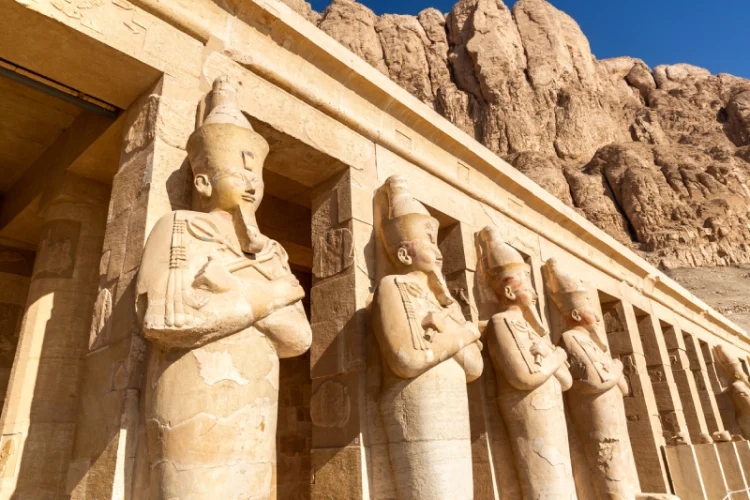
The Temple of Hatshepsut stands out for its distinctive architecture, especially its series of colonnaded terraces that rise gracefully against the cliffs of Deir el-Bahari. Each terrace is lined with elegant columns, enhancing the temple’s majestic appearance and ceremonial function. Long ramps connect the levels, symbolizing the soul’s journey to the afterlife,a key element of ancient Egyptian belief. These unique features make the temple both a spiritual landmark and a remarkable example of Egypt’s architectural innovation.
Inside the Temple of Hatshepsut, visitors can explore chapels and sanctuaries dedicated to various gods, reflecting ancient Egypt's rich polytheism. The Chapel of Hathor on the middle terrace holds special importance, as Hathor was seen as Hatshepsut’s divine protector and mother. This chapel is adorned with finely carved pillars and statues that highlight the artistic excellence of the temple’s builders, making it a key feature of the site’s religious and cultural significance.
The temple’s walls are richly decorated with detailed reliefs showcasing key moments from Hatshepsut’s reign, including her famous expedition to the Land of Punt and various religious rituals. These carvings serve not only as historical records but also as windows into the religious and cultural practices of ancient Egypt. Through their artistry and storytelling, the reliefs highlight Hatshepsut’s legacy and reinforce the temple’s significance as a powerful symbol of Egypt’s ancient civilization and its enduring achievements.
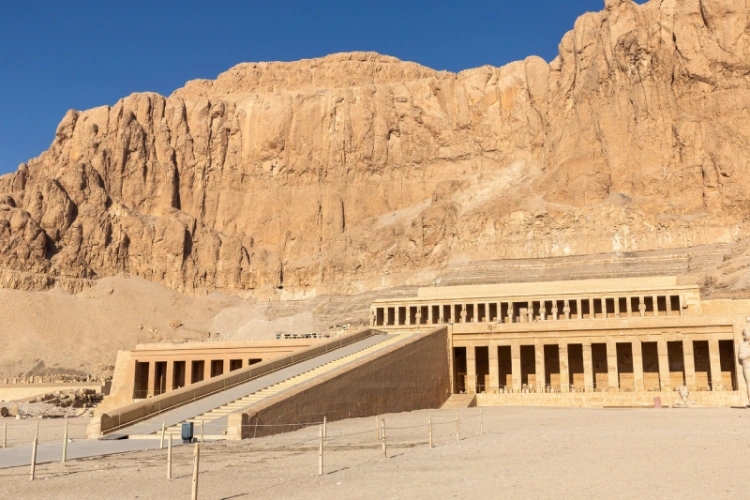
The best time to visit the Temple of Hatshepsut is from October to April, when cooler temperatures make exploring more comfortable. Early morning visits offer softer light and fewer crowds, ideal for appreciating the temple’s beauty. This season also aligns with cultural events in Luxor, such as the Luxor African Film Festival and the Luxor Art Biennale. For photographers, the shifting light across the temple’s terraces and reliefs offers endless visual inspiration. Visiting during these months provides a richer experience, combining ideal weather, vibrant culture, and breathtaking scenery.
1.Unique Female Ruler: Hatshepsut was one of the few female pharaohs in ancient Egypt, and her temple is one of the first monuments built for a female ruler. Her leadership marked a period of prosperity and peace, which is reflected in the grandeur of her mortuary temple.
2.Architectural Innovation: The temple's design, with its terraces and ramps, was groundbreaking at the time, influencing the construction of subsequent temples and monuments in ancient Egypt. Its integration with the natural landscape set a new standard for architectural harmony.
3.Myrrh Trees: Hatshepsut's expedition to the Land of Punt is famously depicted on the temple walls, showcasing the import of myrrh trees. These trees were planted in the temple's courtyard, making it the first recorded instance of tree transplantation in history.
4.Astronomical Alignment: The temple's alignment with the winter solstice sunrise was intentional, reflecting the Egyptians' advanced understanding of astronomy and its significance in their religious practices.
5.Restoration Efforts: The temple has undergone extensive restoration efforts since its rediscovery in the 19th century. Archaeologists and conservators have worked tirelessly to preserve its architectural features and artwork, ensuring its continued survival for future generations.
These fascinating facts highlight the Temple of Hatshepsut's unique place in history and its enduring appeal to scholars, tourists, and history enthusiasts alike.
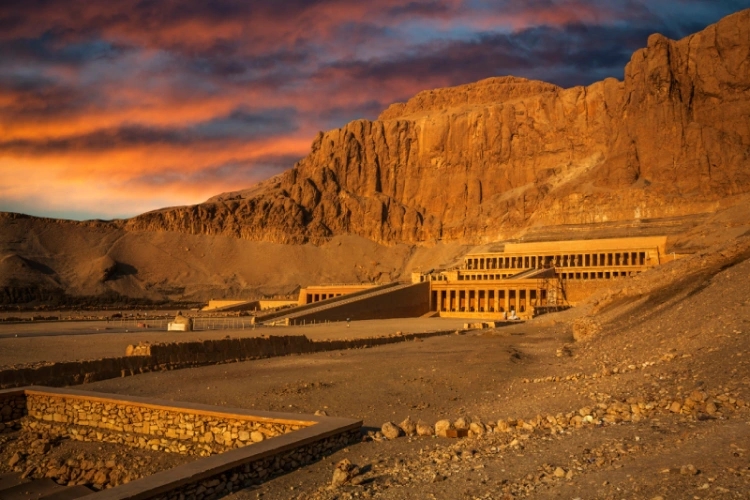
The Temple of Hatshepsut is a stunning symbol of ancient Egypt’s architectural brilliance, artistic mastery, and spiritual depth. Built by one of Egypt’s greatest female rulers, it offers a captivating glimpse into the past through its terraces, chapels, and intricate reliefs. A visit to the temple provides not only historical insight but also a profound connection to the cultural and spiritual legacy of ancient Egypt.
Q1. Where is the Temple of Queen Hatshepsut located?
The Temple of Queen Hatshepsut is located in Deir el-Bahari, near Luxor, on the west bank of the Nile River in Egypt.
Q2. How long did it take to construct the Temple of Hatshepsut?
The construction of the Temple of Hatshepsut took approximately 15 years to complete, beginning in 1479 BCE under the direction of Queen Hatshepsut herself.
Q3. What was the primary purpose of building the Temple of Hatshepsut?
The temple served multiple purposes, primarily functioning as a mortuary temple for Queen Hatshepsut and her father Thutmose I, while also housing shrines to various deities including Amun, Hathor, and Anubis.
Q4. Who was responsible for damaging the Temple of Hatshepsut?
The temple suffered damage from various sources over time, including attempts by Thutmose III to erase Hatshepsut's legacy, Akhenaten's erasure of images of Egyptian gods, and natural disasters such as earthquakes.
Q5. When is the best time to visit the Temple of Hatshepsut?
The ideal time to visit is between October and April when temperatures are mild (15°C to 25°C). Early morning visits, starting from 6 am when the temple opens, offer cooler temperatures and smaller crowds.
Q6. What makes the Temple of Hatshepsut architecturally unique?
The temple's design is remarkable for its harmonious integration with the surrounding landscape, featuring stepped platforms and pillared porticoes set against dramatic limestone cliffs. It was intentionally built on a grander scale than nearby temples to showcase Hatshepsut's power and legacy.
Q7. Is the Temple of Queen Hatshepsut accessible to tourists?
Yes, the temple is a popular tourist destination and can be visited by taking a short ferry ride from Luxor, followed by a taxi or guided tour.
Q8. Can visitors take guided tours of the Temple of Queen Hatshepsut?
Yes, guided tours are available and provide a deeper understanding of the temple’s historical, architectural, and cultural significance.
Q9. How can I reach the Temple of Queen Hatshepsut from Luxor?
From Luxor, you can take a ferry across the Nile River and then a taxi or guided tour to the temple.
Q10. Is there an entrance fee to visit the Temple of Queen Hatshepsut?
Yes, there is an entrance fee to visit the temple, and additional fees may apply for certain services, such as guided tours.
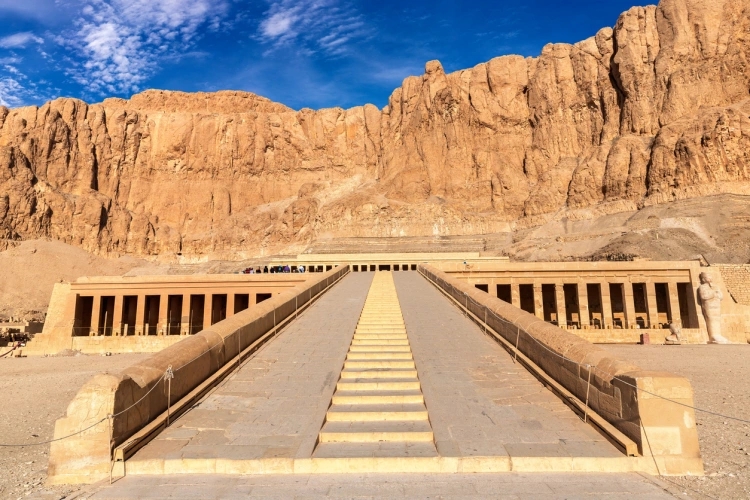

© Copyright 2025 Get Egypt Tour. All rights reserved.